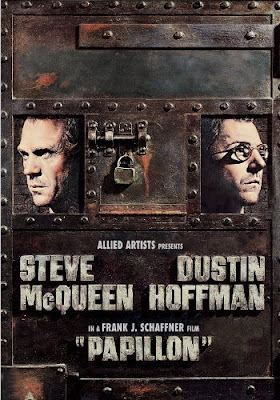Beverly Gray's Blog: Beverly in Movieland, page 23
August 8, 2023
Not Caught Flat-Footed Regarding Barbie
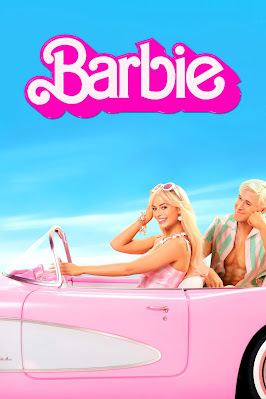
I was the right age to playwith Barbie dolls when they were first introduced to little girls. But mymother wanted no part of these “teen” fashion dolls with their garishly paintedfaces and highly exaggerated proportions, and I tended to agree with her. Personally,I remained content to continue building my “family” of 8-inch Madam Alexandercuties who looked more like me.
Still, I’ve been unable toignore all the hype surrounding the new Barbie movie. I’d hardly beinterested in a flick that simply exalted the plastic pal of so many girls ofmy era. But I was certain that writer/director Greta Gerwig—whose off-centertake on Little Women (2019) is a worthy addition to the LouisaMay Alcott canon—would have something interesting to say. And, hey, I was right.
Gerwig (and herwriting-and-life partner Noah Baumbach) can’t be accused of lacking ambition. Thefilm’s early scenes are an hilarious re-creation of Barbieland, where all thebuildings are pink and all the important jobs (doctor, judge, astronaut,President) are filled by Barbie clones who are simultaneously brainy andbeautiful . . . and of course very well dressed. Ken is here too: amiable, not too bright, andgenerally outfitted for the beach. Before the role-reversal joke can wear out,Stereotypical Barbie (a perfectly-cast Margot Robbie) finds herself starting tofeel actual human emotions, and heads to the Real World to figure out what’sgoing on. Her trip to Southern California puts her in contact, for the first time, withmale misogyny, while the tag-along Ken (Ryan Gosling) discovers that toxicmasculinity—complete with cowboy duds and horses—might improve his lot in life.(A column by Jean Guerrero in yesterday’s Los Angeles Times focuses onthe film’s quiet recognition that the rules for today’s men, as well as today’swomen, might be overdue for a makeover. She urges that we all adopt “Kenpathy”for guys who would rather not be male chauvinists but know no other path.)
There are many details inthis film that are genuinely funny, like the fact that Barbie’s moment of truthcomes when she discovers she can no longer habitually perch on the balls of herfeet, the better to model stilettos. I also loved the presence of Weird Barbie(Kate McKinnon), whose hacked off hair and grotesquely painted features showher to be the victim of some sadistic little human girl’s lurid imagination.The candy-colored enticements of Barbieland should win art-direction love atOscar time. But I was also amused at the fact that Barbie’s native habitat isset against my own hometown, Santa Monica, which in the film looks equallyidyllic and—Gerwig suggests— almost equally plastic. There’s a hilarious momentwhen narrator Helen Mirren suddenly bursts into the story to comment on acasting matter, and Robbie’s very last line is both provocative and smart.
Speaking of smart, there’sthe interweaving in the plot of a sympathetic human mother (America Ferrera)and daughter (Ariana Greenblatt) with strongly mixed emotions about the Barbieworld. And I loved the acknowledgment of Ruth Handler, played in the film by adelightfully appealing Rhea Pearlman, as both Barbie’s original “mother” and astrong businesswoman with a billion-dollar idea. The film, in addition to allits ideas about female empowerment, is open to acknowledging the sheergoofiness of the Barbie empire, which once briefly included a pregnant friendfor Barbie, as well as a little-girl doll who grows before your eyes into anadult body, and a Barbie with a television screen embedded in her posterior. Ohwell, back to the drawing board.
August 4, 2023
Lelia Goldoni, Creature of Shadows
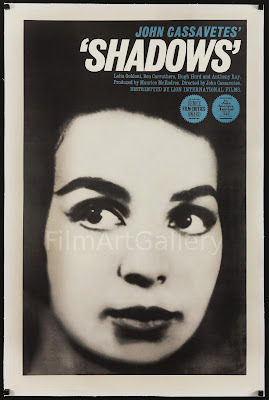
Lelia Goldoni has always beenone of my favorite names, but I certainly didn’t like seeing it in an obituarycolumn. Yet there it was in last week’s Los Angeles Times, a brief notice that Lelia had passed away at the Actors Home in Englewood, New Jersey, atthe ripe old age of 86. (Could that be possible? Lelia as I knew her wasyounger—and lovelier—than springtime.)
I first met Leliawhen my own years were not yet in double digits. I was one of the eager youngstudents at Lester Horton’s Dance Theater, back then a citadel of modern dancethat happened to be located, as one newspaper article put it, on the “wrongcoast.” (Meaning: we were located in West Hollywood., not in New York City.)Lelia was among my teachers, and I also thrilled to see her perform the lead inHorton’s signature dance-drama, Salome. It never occurred to me then that she was not much older than I was.Horton’s used talented teenagers to lead the kids’ classes, and she may havebeen all of 17. She was also smart, feisty, and gorgeous.
I left Horton’s atage 10, but my family and I stayed in touch over the years with some of thedancers. The most promising of them tended to go east, in search of newartistic opportunities. That was the path of Alvin Ailey, who went on to foundthe Alvin Ailey American Dance Theatre, showcasing Alvin’s own choreography and evolving into a still-gloriousnational treasure. In its early days, the Ailey company showcased the danceskills of Carmen de Lavallade, my very first teacher and today the proud recipientof a Kennedy Center honor for her illustrious career in the arts.
Lelia’s own path wasslightly different. She resolutely turned from dance to drama, moving at age 19back to the city of her birth. In New York she joined a workshop run by actorJohn Cassavetes.. A class improvisation about an interracial family—one siblingis dark-skinned and two others pass as white—evolved into Cassavetes’ firstfilm project as a director. Called Shadows, it is set in a bohemian neighborhood of Lower Manhattan, amongbudding musicians and artists. The history of the film is a tangled one: afirst version, entirely improvised with somewhat chaotic results, was releasedin 1958. Cassavetes then reworked the project, formalizing the script andshooting new material, for a 1959 premiere that was hailed as a milestone ofAmerican independent cinema. In both versions Lelia played the vibrant buttroubled sister, trying out multiple romantic relationships as she ponderswhere she belongs in the world. (Ironically, she did not share the backgroundof her character, also named Lelia. Unlike her mixed-race screen persona, sheherself was ethnically Sicilian all the way.)
Following Shadows¸ Leliatook minor roles, sometimes in major productions. She’s remembered as EllenBurstyn’s best buddy in the early scenes of Martin Scorsese’s Alice Doesn’tLive Here Anymore (1974). Later, back in L.A. again, she directed aworkshop production of a play written by her husband, Rober Rudelson. In the1980s, after I‘d interviewed her for a magazine piece on the Horton era, shegraciously invited me to lunch in her modest but colorfully decoratedapartment. When I gazed at a poster for Shadows that highlighted herlovely face, she surprised me by acknowledging, “I was really beautiful then.”She quickly added, “I can say that, because I’m not beautiful now.”
But Lelia always remainedbeautiful, for those with eyes to see.
August 1, 2023
The Perils of Papillon
I’ve always been curiousabout Papillon. This 1973 film, directed by Franklin J. Schaffner (Patton)derives from the purportedly true memoir of Henri Charrière, a low-levelcriminal who successfully escaped from the French penal colony of Devil’sIsland, off the northeastern coast of South America. Grim survival stories arenot especially favorites of mine, but circa 1985 I paid a visit to Guyane (akaFrench Guiana), where a family member was preparing for the launch of anAmerican satellite on a European rocket based at the local space center. Notfar from these high-tech surroundings was the Isle du Diable, and I was luckyto join a group of French journalists touring this infamous but now defunctsite, which was the center of the French penal system from 1852 to 1952.
I don’t remember much aboutthe prison environment, except that it was a hot and brutal place, full ofinsects and other daunting obstacles. Schaffner’s film makes full use of these obstacles,both the natural and the man-made, in telling the story of a bloke with abutterfly tattooed on his chest (hence the nickname Papillon) and anindomitable will to survive. His leading man is Steve McQueen, known throughouthis career as an escape artist par excellence. McQueen is anextraordinarily physical actor, blessed with a hard body and a stoic face thatseems to accept danger as man’s natural lot. His job in this film is to survive,even when locked in a steel cage and deprived of any source of light. Attimes we see his agonized efforts to hold onto his humanity, despite it all.Many feel this is McQueen’s very best work.
I began thinking about Papillonafter I was interviewed by Kelsy Norman, a Canadian film buff (and ultimateMcQueen fan) whose long-running podcast is called SPEEDING BULLITT: THELIFE AND FILMS OF STEVE MCQUEEN. I hardly claim to be a McQueen expert, butKelsy had read my Seduced by Mrs. Robinson: How The Graduate Becomesthe Touchstone of a Generation, and was intrigued by my report of whatMcQueen had told his then-wife, now Neille Adams Toffel, after watching DustinHoffman in 1967’s The Graduate. Said he, “God, baby, I can’t believethis guy’s going to be a movie star, can you? I mean, he is one ugly cat. Goodactor, yeah, but he sure is homely.” McQueen, always secretly insecure, brooded mightily about the possibility thathe and such classically handsome talents as Paul Newman might be shoved asideby the newcomer. Toffel writes in her memoir that “Steve would stare at hisimage in the mirror and say to me, ‘Look at that, baby, take a look at thatface and that body and tell me the truth. Who would you pick, him or me?’ Wewould both laugh, although I knew he was serious.”
As luck would have it, whenMcQueen began work on Papillon, he discovered he’d be playing againstthis very same Dustin Hoffman. Hoffman plays Louis Dega, a fellow prisonerwho’s the polar opposite of Papillon in many ways. Dega is whip-smart, but alsoextremely cautious: there’s nothing of the escape artist about him. In time,against all odds, the two become friends. At perhaps Papillon’s lowest point,when he’s been thrown into solitary with his already bug-infested rationshalved, Dega secretly comes to his aid. But the friendship between the twoprisoners hardly extended to the two actors. McQueen, recognizing Hoffman’stalent, decided he needed to up his game on-screen. But a real-life friendshipbetween the two was not in the cards.
Here's my interview with Kelsy Norman on his Speeding Bullitt podcast, which covers all things Steve McQueen.
July 27, 2023
Parsing Passion in “The French Lieutenant’s Woman”
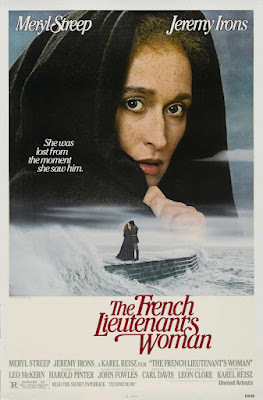
As an English major workingon my doctorate in contemporary fiction, I was not impressed by the work ofBritish novelist John Fowles. My profs and classmates struggled to convince meof the literary daring of Fowles’ 1969 novel, The French Lieutenant’s Woman¸seeing it as boldly venturing into post-modernism by taking aVictorian-style narrative and then figuratively wringing its neck. The novel’s passionately romantic story lineis constantly interrupted by an intrusive narrator, who then provides not onebut two very different (though equally plausible) endings. The question: howwould a motion picture handle this tricky balance between past and present,between Victorian stylistics and the more skeptical approach of the 20thcentury?
Until now, I had stayed clearof the film, even though it was well received, earning 5 Academy Awardsnominations as well as some Golden Globe and BAFTA awards. Predictably, a lotof the attention went to leading lady Meryl Streep. By 1981, when The FrenchLieutenant’s Woman was released in theatres, Streep had already won anSupporting Actress Oscar for Kramer vs. Kramer. And she would be namedBest Actress in the following year, for Sophie’s Choice. Even though theproduction of The French Lieutenant’s Woman was otherwise British allthe way, Streep’s ear for accents coupled with her unrivaled dramatic powersmade her a strong choice for a character who essentially throws away her lifeto satisfy her passions, that being a far cry from the moral codes of VictorianEngland. Her motivations throughout the film remain mysterious, in contrast tothe young scientist (Jeremy Irons) willing to throw everything away for love ofher.
And how did director KarelReisz and his team handle Fowles’ literary gamesmanship? Reisz, whose short butintense British filmography includes Sixties gems Morgan and Isadora,worked closely on this project with one of England’s most formidableplaywrights, Harold Pinter. This future Nobel laureate—whose own stage work isknown for its stripped-down dialogue and ambiguous sense of menace—also wrote along string of screenplays, many but not all of them adapting his own plays.Pinter chose to adapt Fowles’ novel by adding to its story an element that isspecifically post-modern. To be clear, he adds to the original plotting asecond key relationship that took me totally by surprise.
I didn’t realize this when Isat down to watch the film. I just knew that there was Streep, in the blackcloak and hood of the enigmatic Sarah, brooding high above the swirling seas ofLyme Regis. And suddenly there was a 20th century crew memberchecking Streep’s makeup, and letting the actress examine it for herself in avery contemporary-looking mirror. Films don’t usually commence with a reminderthat they are full of fakery, so I waited impatiently to see how this moderntouch paid off. And suddenly, a few scenes later, Jeremy Irons’ characterrolled over in bed and picked up what looked to be the receiver of a 1980stelephone. Say what?
As I was soon to discover, this screen version of Fowles’novel contains two parallel stories, that of a Victorian man and woman drawntogether by mysterious emotional forces and that of an actor and actress onlocation, playing these roles for the camera while negotiating their owntangled love affair. Since the two performers are not themselves Victorian,they have fewer social boundaries to negotiate. So they can easily succumb tosexual temptation (something that often prevails on a movie set). But thishardly stops them from butting up against complications that challenge their 20th century “post-modern”affair.
July 25, 2023
Spoiler Alert: Seeing The Last of Mrs. Maisel
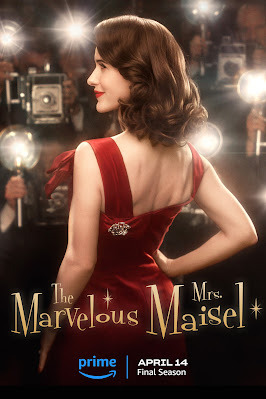 Well, Midge Maisel has goneto her reward, which seems to involve lounging on a couch in a mansion,watching Jeopardy with still-buddy Susie. It’s not the ending I wouldhave chosen for the final season of this memorable sitcom. But wrap-ups arehard. All the emotion we’ve put into watching the evolution of the often fractiousMaisel/Weissman clan over five years of TheMarvelous Mrs. Maisel is supposed to pay off in the final episodes. But forme, the fifth season turned out to be a hodgepodge of scrambled stories,skipping back and forth through time in an effort to sum up everyone’ssituation. I would have been content to see Midge—the affluent late Fifties housewife who was dumped by her NiceJewish Boy husband, only to discover her natural gift for stand-up comedy—goout either a winner or a loser. But the writers seemed to want to have it bothways. Midge scores the TV gig that makes everyone, both family and the viewingpublic, adore her. Hooray! But then wehave to endure the painful disintegration of her friend, Lenny Bruce, andseveral additional mordant moments before that couch scene (featuring Susie in a mop of a grey wig and acaftan) with its final fadeout.
Well, Midge Maisel has goneto her reward, which seems to involve lounging on a couch in a mansion,watching Jeopardy with still-buddy Susie. It’s not the ending I wouldhave chosen for the final season of this memorable sitcom. But wrap-ups arehard. All the emotion we’ve put into watching the evolution of the often fractiousMaisel/Weissman clan over five years of TheMarvelous Mrs. Maisel is supposed to pay off in the final episodes. But forme, the fifth season turned out to be a hodgepodge of scrambled stories,skipping back and forth through time in an effort to sum up everyone’ssituation. I would have been content to see Midge—the affluent late Fifties housewife who was dumped by her NiceJewish Boy husband, only to discover her natural gift for stand-up comedy—goout either a winner or a loser. But the writers seemed to want to have it bothways. Midge scores the TV gig that makes everyone, both family and the viewingpublic, adore her. Hooray! But then wehave to endure the painful disintegration of her friend, Lenny Bruce, andseveral additional mordant moments before that couch scene (featuring Susie in a mop of a grey wig and acaftan) with its final fadeout. The fifth season has beenlike that from start to finish. Several episodes begin, at first bafflingly,with flash-forwards to Midge’s now-adult children. I liked the possibilities ofa full-grown Ethan picking vegetables and studying rabbinics on an Israelikibbutz, though Midge suddenly landing in a helicopter to check out him and hiscranky Sabra bride seems a pretty lame joke. As for daughter Esther, previouslyseen only as tiny child, it took me a while to figure out that SHE had grown upto be the brilliant young scientist discussing family with her shrink in thisseason’s opening episode. There is also a wacky suggestion that Midge is at onepoint about to marry novelist Philip Roth in a lavish Hawaiian ceremony. Thisbrief plot strand—enlivened by parents Rose and Abe’s predictablehysteria—quickly disappears both from the series and from the characters’psyches, as do some of the key relationships from previous seasons. Case inpoint: ex-husband Joel’s feisty Chinese-American spouse-to-be, along with theirimpending child. (Actress Stephanie Hsu who played Mei Lin, has done very well for herself lately, nabbingan Oscar nomination for Everything Everywhere All at Once. So perhapsshe had to be surgically removed from Joel’s and the viewer’s mind.)
Why was I a fan of thisseries? Perhaps because it was such a funny and familiar take on ethnictribalism, along with an acknowledgment of what young women faced in the MadMen era Two of my favorite characters were Midge’s parents, played by MarinHinkle and the invaluable Tony Shalhoub. Their obsessions with style (her) andintellectualism (him) always rang true, and their relationship with one anotherhad the hilarious push-and-pull of many a marriage. Their firm grasp of theirJewish social and religious values were, to me at least, funny but neverinsulting. My very favorite season was the one in which the whole family groupdecamps to a legendary resort in the Catskills (read: Grossinger’s). Later,when the resort’s beloved social director opens a play on Broadway, Abe is putin the terrible position having to review this stinker for the VillageVoice. Quickly he pays the price, as an entire congregation of his peersaudibly shames him during High Holiday services for betraying one of their own.It’s uproariously funny, and it sure feels real.
July 21, 2023
Not Hedley but HEDY Lamarr: Screen Siren and Science Whiz
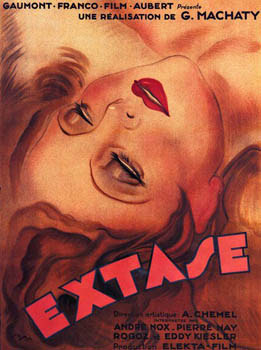 French poster for "Ecstasy"
French poster for "Ecstasy"Hedy Lamarr? I’ve never seen Ecstasy,the 1933 Czech film (with certain similarities to Lady Chatterley’s Lover)in which she swam naked and allowed her face to suggest the joys of an orgasmicencounter. The film of course met resistance in many nations, including theU.S., where it was denied the seal of the all-important Hays office. That’s whyits American release was limited to a few independent art houses.
Back then Lamarr was stillbilled as Hedy Kiesler, the name with which she was born in 1914 Vienna. Theonly child of Jewish parents (though her mother apparently adopted Christianityearly on), she quickly showed she had brains as well as beauty. Her father, whoadored her, enjoyed talking to young Hedy about technology. But once shedeveloped a passion for acting, she devoted her energies to advancing her stageand screen career. At 18, while playing the youthful Empress Elisabeth in ahighly regarded Vienna theatre production, she attracted scores of admirers.One was 33-year-old Friedrich Mandl, a hugely wealthy munitions manufacturerwith close ties to Mussolini and later to Hitler.
Why exactly did she marry thisdomineering man, who made her give up her acting career in order to play thepart of a dutiful wife? A 2019 historical novel, Marie Benedict’s The OnlyWoman in the Room, claims her father encouraged her in the marriage, as away of potentially saving herself and her family from a rising tide of anti-Semitism. I have no faith in Benedict as an in-depth researcher, but shealso posits that much of Lamarr’s later life in Hollywood was marked by herguilt over the fact that she was aware of, but had no way to stop, Hitler’smurderous plot against Europe’s Jews.
But the marriage itself soonturned dangerous, with Hedy being treated by her spouse as a prisoner in herown home (by which I mean a castle or two). She escaped to England, where she quickly cozied up to Louis B. Mayer,who was abroad looking for new talent. It was he and his MGM colleagues whogave her a new last name, promoted her as the “world’s most beautiful woman,”and starred her in exotic vehicles like 1938’s Algiers with CharlesBoyer. The role of an exotic seductress became her specialty, in films such as WhiteCargo (1942) and Samson and Delilah (1949).
The most unlikely aspect ofLamarr’s biography is the fact that, at the height of World War II, she joinedwith avant-garde composer George Antheil to support the anti-Nazi cause bydeveloping a radio guidance system for Allied torpedoes. Her invention, whichwas patented but never accepted by the U.S. military, “used spreadspectrum and frequency-hoppingtechnology to defeat the threat of jammingby the Axis powers.” (I’m quoting here from the evcr-usefulWikipedia, but I have no idea what I’m saying.) Apparently their discovery has now contributed hugely to the rise ofcellphones, so I’m not sure if we should be grateful or not.
Meanwhile, as an Americanmovie star of the Golden Age, Lamarr accepted the fact that her main functionwas to be beautiful. Though her invention didn’t help win the war, she sold awhole lot of war bonds by guaranteeing to kiss young soldiers if enough money wasraised on the spot. But personal happiness remained elusive. After six failed marriages, she lived most ofher later life in seclusion. One oddity: her 1976 lawsuit claiming that thecomic use of the name Hedley Lamarr for Harvey Korman’s character in MelBrooks’ Blazing Saddles violated her right of privacy.

July 18, 2023
Julian Sands Tragically Sought a Hike with a View

Last January, L.A. radiostations announced that English actor Julian Sands had gone missing. A seasonedhiker, the sixty-five-year-old Sands had set out for a solo excursion near Mt.Baldy, the highest peak in the San Gabriel Mountains. In a year marked bymassive amounts of snow in Southern California, the search for Sands wasrepeatedly delayed. But eventually scores of volunteers hit the trail, lookingfor any trace of the missing actor. It was not until June that his remains werediscovered and identified.
The sad news of Sands’ demiseled me to return to his breakthrough role, as handsome young George Emerson in1985’s A Room with a View. This screen adaptation of a work by E.M.Forster set the standard for the cinematic transformations of major novels, throughthe collaboration of James Ivory (director), Ismail Merchant (producer), andRuth Prawer Jhabvala (writer). This longstanding team, specializing insumptuous, intelligent costume dramas, was once a powerful force in the movieindustry, particularly in the last two decades of the 20th century. AsMerchant put it, “It is a strange marriage we have at Merchant Ivory . . . I aman Indian Muslim,Ruth is a German Jew, and Jim is a Protestant American. Someone oncedescribed us as a three-headed god. Maybe they should have called us athree-headed monster!”
A Room with a View captures theelegant yet repressive mores of Edwardian England, circa 1908. Its openingscenes are set in Florence, Italy, where a group of well-endowed English travelers gather over dinner at a localpensione. The youngest of them, newcomer Lucy Honeychurch (Helen BonhamCarter), laments that her room lacks the promised view of the River Arno. WhimsicalMr. Emerson (Denholm Elliott) volunteers that he and his son will gladly swaprooms, but Lucy’s stuffy guardian, cousin Charlotte (Maggie Smith), isreluctant to do anything unseemly.
Throughout the film, Lucy is tornbetween the wish to obey social norms and a youthful eagerness to experiencelife in the raw. Her chance to elude her chaperone’s supervision comes when shevisits the basilica of Santa Croce, only to find herself steps away from aviolent stabbing. She faints, but is rescued by Mr. Emerson’s strapping blondson (Sands), a young man nearly bursting with a strongly romantic temperament.From this point forward, George Emerson finds moments to express his ardor forLucy. This upends her Florentine sojourn: Charlotte whisks her back to herfamily’s country estate, where she tries hard to resume the life of a demureyoung English lady.
Quickly there’s an engagementto Cecil Vyse, a supercilious English intellectual (Daniel Day-Lewis), wholooks with disdain on anything that might smack of impropriety. (He haughtilyscorns a delightful scene of Lucy’s brother and others cavorting in the buff ina neighborhood pond.) But inevitably Lucy will discover the need to rethink herchoice of a husband. The film’s ecstatically happy ending provides love,rapturous kisses, and of course a room with a view.
Sands’ character is presentedon-screen as something of a conundrum, even to his loving father. Saved byfamily wealth from the need to choose a profession, he seems to live to revelin beauty in all its forms. His lust for life is distinctive, especially whenhe’s placed among his more prosaic countrymen. Obviously, a man is more thanthe sum of the characters he plays on screen. Still, it’s easy to imagine GeorgeEmerson’s life being suddenly snuffed out on a solo hike into the wilderness. Ihope that Sands enjoyed a wonderful view before he died.
July 14, 2023
Mary Tyler Moore: She Turned the World On With Her Smile (but she wasn’t always smiling)

The pandemic re-introduced meto the simple joys of TV’s long-running Mary Tyler Moore Show. From 1970through 1977, the nation watched MaryRichards (a smart and attractive single gal with a megawatt smile) at home inMinneapolis, where she toiled in a local TV station’s newsroom while alsohanging out with pals and occasionally dating someone who never turned out tobe Mr. Right. The description hardly sounds like much, but the show’s writingand its casting were so smart that viewers turned in week after week. At thetime, Moore was remembered by sitcom fans as the wife of Dick Van Dyke on his long-runningseries. The show that bears HER name introduced us to Ed Asner (who went on toplay his curmudgeonly Lou Grant character on a fine dramatic series set at anurban newspaper), Ted Knight (as doofus newscaster Ted Baxter). Valerie Harper(as Mary’s lovelorn buddy, Rhoda Morgenstern), Cloris Leachman (as Mary’s ditsylandlady), and the inimitable Betty White (as the station’s s man-hungry “HappyHomemaker”). Tying it all together was plucky Mary: a female maneuvering in aman’s world while trying not to let her natural femininity get quashed.
Mary Tyler Moore, originallyan aspiring dancer, moved from TV commercials to sitcoms with ease. She seemedto have it all, despite a background that was more wine than roses. As madeclear in a recent documentary, Being Mary Tyler Moore, alcoholism randeep in her family. So did early deaths: her sister died of painkillers andalcohol at age 21; her brother succumbed to kidney cancer at 47; her only sondied of an accidental gunshot wound at 24. She herself struggled with diabeteswhile also managing to surmount years of alcoholism.
One of the painful ironies ofher son’s death was that it came a mere three weeks after the release of herall-time major film role, that of a bereaved mother in Robert Redford’sdirectorial debut, Ordinary People (1980). The film, based on a novel byJudith Guest, zeroes in on an affluent suburban family rocked by the death ofits eldest son in a boating accident. Tyler Moore played a woman whoseconsiderable social charm masks a rigidity that makes her unable to showcompassion toward the younger son (Timothy Hutton) whose guilt for his part inthe accident is destroying his life. The film was named Best Picture by theAcademy, and Hutton’s youthful performance (he was 20) won him a SupportingActor Oscar. Tyler Moore was nominated too, in the Lead Actress category,though she lost out to Sissy Spacek for CoalMiner’s Daughter. But the role of Beth Jarrett showed the world she coulddo far more than be perky.
There were to be manydisappointments in her life, like the last-minute cancellation of a musicalversion of Breakfast at Tiffany’s inwhich she was set to star on Broadway. Her first marriage, at age 18, dissolvedquickly. Her second, to TV executive Grant Tinker, with whom she founded the highlysuccessful MTM Enterprises, also ended in divorce. Unexpectedly, she fell for a29-year-old cardiologist, Dr. Robert Levine, when she was in her late forties.To everyone’s surprise, they remained married for 34 years until her death in2017. He continues to be devoted to her memory, and was deeply involved with the making of thedocumentary film. The doc contains frank interviews with Mary, showing her tobe far more thoughtful about her personal lapses than one might guess. It alsochronicles her passion for animals and for ever-changing hair-dos.
July 11, 2023
And Here’s to YOU, Larry Turman
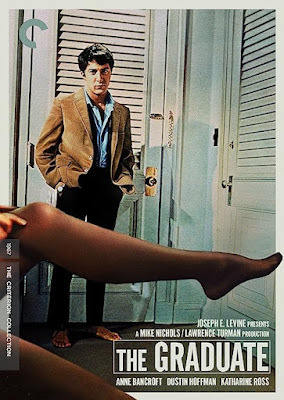
The passing of Hollywoodproducer Lawrence Turman at age 96 has, I’m glad to say, not gone unnoticed.Turman produced 42 films, directed two, and spent the last three decades of hislife teaching his trade to graduate students as the head of the Peter Stark Producing Program at USC. Igot to know him while researching Seduced by Mrs. Robinson, my 2017 bookon the long-term impact of Turman’s best-known film, The Graduate. Releasedin 1967, The Graduate was a worldwide smash that briefly catapulted thethen-41-year-old Turman into the top ranks of Hollywood players. He enjoyed the notoriety, but hardly let itgo to his head. The man I first met at his USC office in 2007 was both cordialand feisty. Above all, I quickly recognized him as a straight-shooter.
This became clear when our chat turned to the topic of Larry’sdirectorial debut. His goal was to bring to the screen another racy comedy bythe original author of The Graduate, Charles Webb. But The Marriageof a Young Stockbroker (1971) turned out to be a disappointment, one forwhich he now blames himself. ComparingDustin Hoffman, whose career was launched with The Graduate, to the young actor he cast in Stockbroker,Larry admitted, “There’s a reason Dustin Hoffman is a movie star and RichardBenjamin is not. Dustin is vulnerable and likable; Richard Benjamin, wonderfulguy and a wonderful actor, he comes across on screen as brittle, cold, distant.”He now admits to having made, among many other errors, an unfortunate castingchoice.
While exploring the papers onthe making of The Graduate in Larry Turman’s archives, I was surprised to come across glossy photosof what looked to be a stag party. The men in the film’s cast and crew, perchedon folding chairs, were being cozily entertained by two cuties wearing highheels, bikini bottoms, and nothing else. When I asked Larry about thecircumstances, he sniffed, “If they had that party, they didn’t invite me, theproducer.” That’s when I pulled out a photo, and he expressed surprise, “That’sme on Mike Nichols’ left.” An audition? I strongly doubt it.
Larry’s 2005 book, So YouWant to be a Producer, lays out in clear-cut terms what it takes to succeedin his field. But he cautions aspirants against being overly ego-driven. Casein point: some years back he saw an announcement of a Motion Picture Academy screeningof The Graduate, with director Mike Nichols as the evening’s honoredguest. Wrote Larry, “No mention of me whatsoever. If you’ve read this far, youknow I think the world of Mike, but TheGraduate exists as a film only because of me. So you want to be aproducer?”
Fortunately for me, I’drather be a writer than a producer. And Larry was enormously helpful to me inclarifying why and how The Graduate was made. We did some jockeying overinterpretations: I refused to accept that Katharine Ross’s character, thelovely Elaine Robinson, remains passive throughout. (After all, she comes toBen’s Berkeley rooming house at midnight demanding to be kissed.) On the otherhand, I learned something important: that although The Graduate seemedremarkably timely to college students in 1967, the thinking throughout theproduction was that the story took place circa 1963. (Hence, no Vietnamreference at all.)
When my book came out, Iinvited Larry to lunch as a thank-you, and afterwards received an email Icherish: “Lunch was very enjoyable and even enlightening. Thank you againfor initiating it. You’re formidable.”
So were you, Larry. So wereyou.

July 4, 2023
Born in the U.S.A.: Indiana Jones and Asteroid City

There was a time, back in theThirties and Forties, when Hollywood backlots stood in for all the exoticplaces on the globe. You needed to set your story in a Casablanca bazaar? AnIrish village? An exotic palace high in the Himalayas? If SoCal couldn’t find asuitable location, perhaps you went as far away as Yuma, Arizona (where Crosbyand Hope filmed Road to Morocco). Back then, Hollywood studios’screenplays circumnavigated the globe, but their production was strictlyall-American.
How things have changed! Ijust saw Wes Anderson’s new Asteroid City, an all-star meditation on thedifference between reality and artistic invention. Some of it is apparently setin New York, where a TV documentary captures the evolution of a fledgling theatrepiece written by Broadway great Conrad Earp (Edward Norton). Most of it—showingthe playing-out of Earp’s artistic vision—is set in a candy-colored version ofthe American Southwest, complete with a quaint filling station, a roadsidecafé, and a bungalow court, as well as a freight train that passes through nowand again. This out-of-the-way place, known as Asteroid City, gets its namefrom a small globule of space junk that once landed here. Now it’s the locationof a modest but prestigious gathering of military brass, some “brainiac” kidswho’ve won a science competition, and their eclectically assorted parents. Anddid I mention there’s an alien sighting?
The locale, the cast, and thebackground music (lots of old western tunes that would surely make the CoenBrothers happy) all shriek Americana. So I was more than a bit surprised, inreading the closing credits, to discover that Asteroid City was shot largely in Spain, with additional production units in France and Italy. I’m surethe financing of the film had something to do with the choice of shooting locations.Anderson, who has made such films as The Darjeeling Limited, and TheFrench Dispatch, has a great affinity for exotic locales. By choosing toshoot in far-flung corners of the globe, he’s doubtless come up with somelucrative funding sources that depend on him filming far from Hollywood, evenwhen he’s dealing with all-American subject matter.
I like Anderson’s loopyvision of the world, and it’s fun to see such major talents as ScarlettJohansson, Steve Carell, Bryan Cranston and even Tom Hanks pop up in offbeatroles. (Jeff Goldblum is billed as the alien.) The approach worked beautifullyin probably my favorite Anderson ensemble flick, The Grand Budapest Hotel. (Hissensitive coming-of-age romance Moonrise Kingdom is lovely butstylistically uncharacteristic.) But it certainly helps, when the canvas is sobroad, if we care about the characters, and if the film is actually aboutsomething coherent. In Asteroid City, Anderson’s movement back and forthbetween the behind-the-scenes creation of a drama and the actual playing out ofthe finished version can be seen as meaningful . . . or simply aggravating. Me,I’ll go with the latter adjective.
But of course the big newsthis week is about the launching of Indiana Jones and the Dial of Destiny. Talk about Americana—and a greatfilm with which to kick off a holiday weekend. No, I didn’t choose to brave whatI hope will be big crowds at the multiplex (today’s film industry needs all theblockbusters it can get). But I rented Indiana Jones and the Last Crusade, inwhich Harrison Ford gets to play (delightfully) against old pro Sean Connery.Indie’s crusty dad may be Scottish, but the man himself is a strong, smart,courageous All-American. July 4 doesn’t get much better than that.
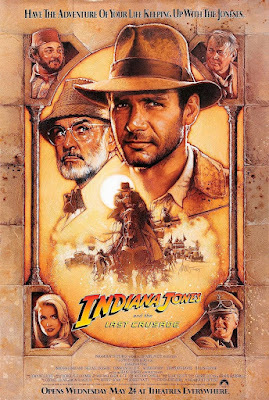
Beverly in Movieland
- Beverly Gray's profile
- 10 followers


